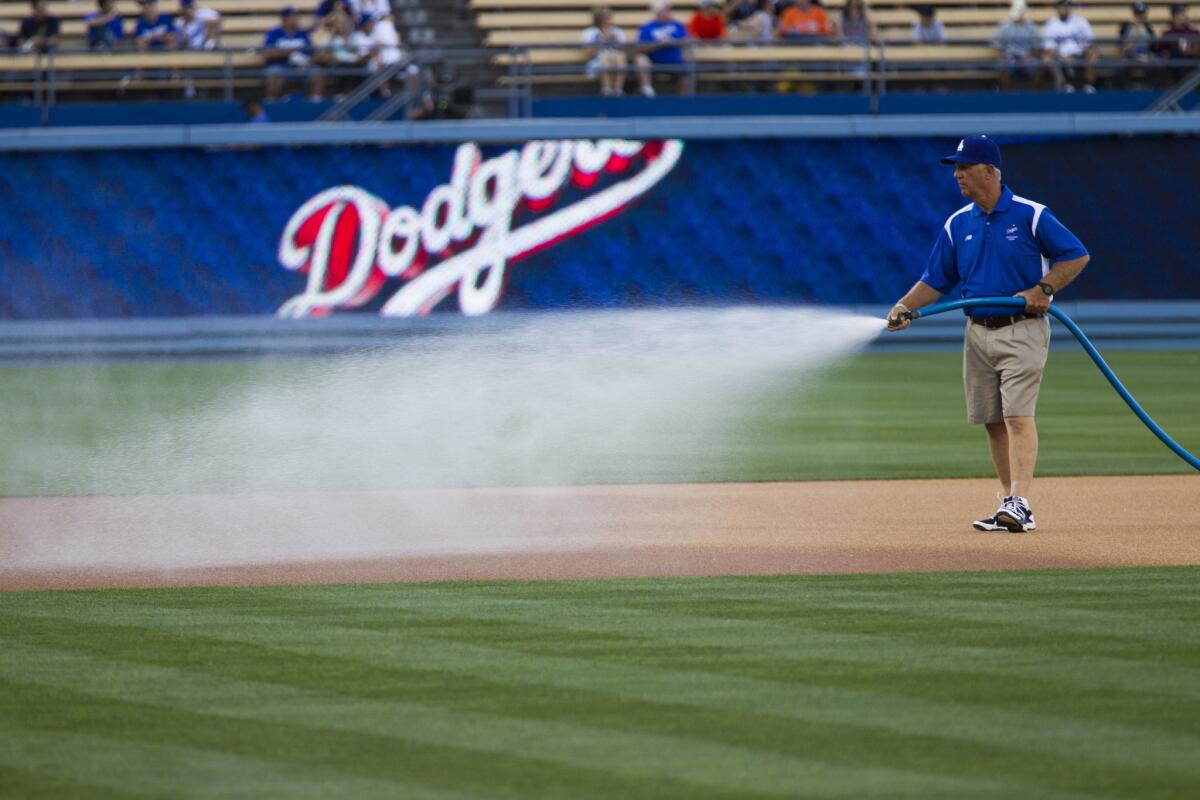Drought spurs sports to look at water use on fairways and fields

A member of the Dodger Stadium grounds crew waters the field before a game in April. New electronic sensors send real-time data -- moisture, temperature and salinity -- that tell when sprinklers have sufficiently drenched the soil.
That spot down the fairway, just past the dogleg, might be perfect for a new bunker. Jack Nicklaus imagines a hazard that would force golfers to choose.
Lay up short or try to hit over?
“Heaven forbid somebody would have to think,” Nicklaus says with a smile. “Especially a golfer.”
It is a cool Friday morning, and perhaps the greatest player ever is planning a massive renovation at Sherwood Country Club. Most of the notes he scribbles in a thick binder deal with reshaping greens and moving tees, but there is something else to consider: the drought.
In coming months, his design firm will oversee the installation of high-efficiency irrigation and add native plants to the Thousand Oaks course. Workers will strip away seven or more acres of turf in places where members rarely hit the ball.
“Water is a big issue right now,” Nicklaus says. “You have to be aware of what you’re doing.”
In the midst of a historic dry spell, with Gov. Jerry Brown demanding that Californians reduce water usage by 25%, sports such as golf, baseball and football must find new ways to care for acres of grass.
Dodger Stadium has installed underground technology to cut back on sprinkler times. UCLA has gone a step further, replacing one of its athletic fields with synthetic turf.
“There has been a vast amount of overuse,” said David Muller of the Green Sports Alliance, a nonprofit group in Portland. “A lot of it is training people to use only as much water as necessary.”
::
A patch of grass near first base at Dodger Stadium has turned grayish-green. The groundskeeper tests the spot with his shoe and, when the blades fail to spring back up, he knows that the soil has turned dry.
Maintaining a pristine diamond for television cameras has become trickier the last few seasons.
“We’ve taken a look at every aspect of our operation,” says Eric Hansen, the team’s assistant director of turf and grounds. “We’ve gone back to fundamentals.”
That means walking the field hours before each game, looking for signs of struggling turf. It means getting some high-tech help to irrigate more efficiently.
New electronic sensors buried throughout the infield and outfield send real-time data — moisture, temperature and salinity — that tell Hansen precisely when his sprinklers have sufficiently drenched the soil.
“I’ve got a set of eyes underground,” he says. “It turns out that 10 minutes doesn’t do me any more good than seven.”
The sensors also keep track of vulnerable areas around home plate, which get a lot of traffic, and in the outfield where players wear down the grass by standing in one place. When problems arise, Hansen and his crew can react in smarter ways.
In the past, they might have treated the dry spot near first base by running the sprinklers a little longer throughout the area. Now they can pinpoint a few square feet that need help and water by hand.
That keeps trouble from spreading.
“If we have healthy turf,” he says, “we’ll use less water.”
::
With residents and businesses forced to make deep and sometimes painful cuts, groundskeepers worry athletic fields will become public scapegoats.
“People drive by and see all that grass,” says Craig Kessler, director of governmental affairs for the Southern California Golf Assn. “They’re very visible in terms of water usage.”
Even before Gov. Jerry Brown called for reductions, tractors began ripping up an 11-acre intramural field at UCLA. The grass is being replaced by synthetic turf.
“This isn’t the first rodeo for us in terms of state mandates,” says Ken Weiner, a UCLA senior associate athletic director. “And that field was a water hog.”
The artificial stuff is no panacea — it must be washed periodically and cooled on hot summer days. Still, UCLA could save as much as 6.5 million gallons annually.
That is enough water to supply about 200 Los Angeles Department of Water and Power households for a year, according to recent data.
At USC, a weather station beside the baseball stadium adjusts irrigation for grass fields by calculating the moisture that evaporates from plants and soil. “We’re not guessing anymore,” said Eric Johnson, operations director.
The situation gets a bit more complicated for the L.A. Unified School District, which devotes about 2 billion gallons annually to athletic fields and play areas on hundreds of campuses.
With no way of installing synthetic turf or the latest monitors in so many locations, the district has launched pilot programs to irrigate with collected rainfall and treated sewage water. Officials have also installed high-efficiency showers in locker rooms, which points to another area where sports can conserve.
Stadiums such as the Rose Bowl have retrofitted their restrooms with more than 200 waterless urinals. The Green Sports Alliance has seen venues in other states install catchment basins that collect and save rainwater for reuse.
Dodger officials have cut irrigation run times an estimated 50% to 75% by landscaping with mulch and drought-tolerant plants and watering with drip systems around the ballpark. The team has also stopped washing the stadium with pressure hoses after every game. Crews rotate through sections and do a lot more sweeping and mopping.
“We’re making adjustments where we have to,” said Steve Ethier, a senior vice president. “It’s the right thing to do, and many times it makes good business sense.”
::
Golf’s big dilemma began in 1956 when CBS first broadcast the Masters from lush Augusta National in Georgia.
“Bright green everywhere,” Muller said. “It set a standard.”
Even in warm, dry Southern California, course designers sought to re-create that wall-to-wall verdure. People in the sport call it “the Augusta factor.”
Now many courses in the Western U.S. are shifting toward another archetype — the rugged, brown terrain of Scotland, where golf was born.
The management at Oakmont Country Club in Glendale studied black-and-white photos from when the course opened in 1922. They saw a more-Mediterranean look and have set about replacing more than 30 acres of grass with hard-packed sand and drought-tolerant vegetation.
“That includes areas between tee boxes and fairway, so you hit over them,” said Scott Heyn, the general manager. “If you go way off line, you’re into the California native.”
At Sherwood, the club will get a rebate — just like homeowners — for every square foot of grass it replaces. Management hopes to save 30% on a water bill that doubled to $630,000 last year.
That’s where Nicklaus comes in.
Asked about the Augusta factor, the six-time Masters champion leans forward and whispers: “We can’t afford it anymore.”
Not that he pretends to be an expert on computerized irrigation or indigenous vegetation — “I have smarter people doing that” — but conservation appeals to him.
Golfers will have to accept a different ambience. They will acclimate to courses that go brown during certain seasons.
“Times change,” Nicklaus says. “There has to be a balance.”
Twitter: @LATimesWharton
More to Read
Sign up for Essential California
The most important California stories and recommendations in your inbox every morning.
You may occasionally receive promotional content from the Los Angeles Times.











